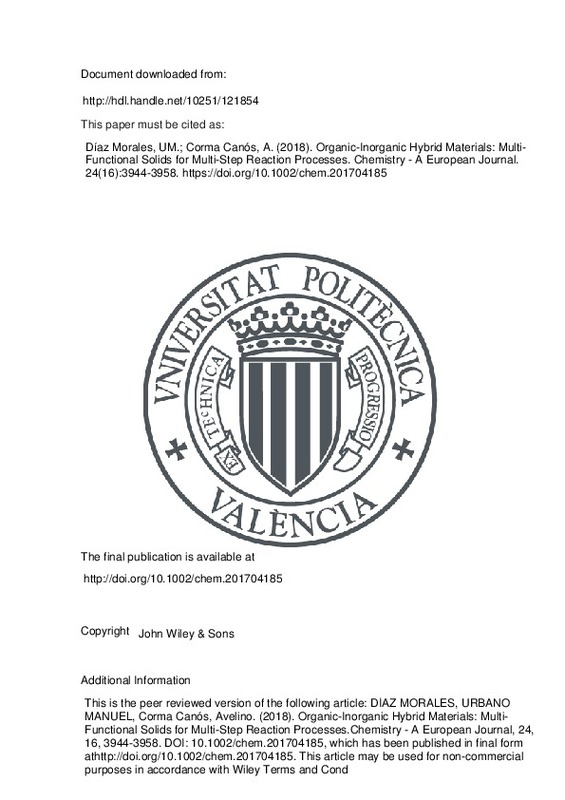JavaScript is disabled for your browser. Some features of this site may not work without it.
Buscar en RiuNet
Listar
Mi cuenta
Estadísticas
Ayuda RiuNet
Admin. UPV
Organic-Inorganic Hybrid Materials: Multi-Functional Solids for Multi-Step Reaction Processes
Mostrar el registro sencillo del ítem
Ficheros en el ítem
| dc.contributor.author | Díaz Morales, Urbano Manuel
|
es_ES |
| dc.contributor.author | Corma Canós, Avelino
|
es_ES |
| dc.date.accessioned | 2019-06-09T20:25:20Z | |
| dc.date.available | 2019-06-09T20:25:20Z | |
| dc.date.issued | 2018 | es_ES |
| dc.identifier.issn | 0947-6539 | es_ES |
| dc.identifier.uri | http://hdl.handle.net/10251/121854 | |
| dc.description | This is the peer reviewed version of the following article: DÍAZ MORALES, URBANO MANUEL, Corma Canós, Avelino. (2018). Organic-Inorganic Hybrid Materials: Multi-Functional Solids for Multi-Step Reaction Processes.Chemistry - A European Journal, 24, 16, 3944-3958. DOI: 10.1002/chem.201704185, which has been published in final form athttp://doi.org/10.1002/chem.201704185. This article may be used for non-commercial purposes in accordance with Wiley Terms and Cond | |
| dc.description.abstract | [EN] The design of new hybrid materials with tailored properties at the nano-, meso-, and macro-scale, with the use of structural functional nanobuilding units, is carried out to obtain specific multi-functional materials. Organization into controlled 1D, 2D, and 3D architectures with selected functionalities is key for developing advanced catalysts, but this is hardly accomplished using conventional synthesis procedures. The use of pre-formed nanostructures, derived either from known materials or made with specific innovative synthetic methodologies, has enormous potential in the generation of multi-site catalytic materials for one-pot processes. The present concept article introduces a new archetype wherein self-assembled nanostructured builder units are the base for the design of multifunctional catalysts, which combine catalytic efficiency with fast reactant and product diffusion. The article addresses a new generation of versatile hybrid organic-inorganic multi-site catalytic materials for their use in the production of (chiral) high-added-value products within the scope of chemicals and fine chemicals production. The use of those multi-reactive solids for more nanotechnological applications, such as sensors, due to the inclusion of electron donor-acceptor structural arrays is also considered, together with the adsorption-desorption capacities due to the combination of hydrophobic and hydrophilic sub-domains. The innovative structured hybrid materials for multipurpose processes here considered, can allow the development of multi-stage one-pot reactions with industrial applications, using the materials as one nanoreactor systems, favoring more sustainable production pathways with economic, environmental and energetic advantages. | es_ES |
| dc.description.sponsorship | The authors are grateful for financial support from the Spanish Government by MAT2014-52085-C2-1-P and Severo Ochoa Excellence Program SEV-2016-0683. The European Union is also acknowledged by ERC-AdG-2014-671093-SynCatMatch. | es_ES |
| dc.language | Inglés | es_ES |
| dc.publisher | John Wiley & Sons | es_ES |
| dc.relation.ispartof | Chemistry - A European Journal | es_ES |
| dc.rights | Reserva de todos los derechos | es_ES |
| dc.subject | Cascade reactions | es_ES |
| dc.subject | Hybrid materials | es_ES |
| dc.subject | Multi-functional materials | es_ES |
| dc.subject | Nanobuilder units | es_ES |
| dc.subject | Nanotechnology | es_ES |
| dc.subject | Sensor | es_ES |
| dc.subject.classification | QUIMICA ORGANICA | es_ES |
| dc.title | Organic-Inorganic Hybrid Materials: Multi-Functional Solids for Multi-Step Reaction Processes | es_ES |
| dc.type | Artículo | es_ES |
| dc.identifier.doi | 10.1002/chem.201704185 | es_ES |
| dc.relation.projectID | info:eu-repo/grantAgreement/MINECO//SEV-2016-0683/ | es_ES |
| dc.relation.projectID | info:eu-repo/grantAgreement/EC/H2020/671093/EU/MATching zeolite SYNthesis with CATalytic activity/ | es_ES |
| dc.relation.projectID | info:eu-repo/grantAgreement/MINECO//MAT2014-52085-C2-1-P/ES/NUEVOS MATERIALES CON DIFERENTES CENTROS ACTIVOS INCORPORADOS EN POSICIONES ESPECIFICAS DE LA RED Y SU APLICACION PARA PROCESOS CATALITICOS MULTI-ETAPA Y NANOTECNOLOGICOS/ | es_ES |
| dc.rights.accessRights | Abierto | es_ES |
| dc.contributor.affiliation | Universitat Politècnica de València. Departamento de Química - Departament de Química | es_ES |
| dc.description.bibliographicCitation | Díaz Morales, UM.; Corma Canós, A. (2018). Organic-Inorganic Hybrid Materials: Multi-Functional Solids for Multi-Step Reaction Processes. Chemistry - A European Journal. 24(16):3944-3958. https://doi.org/10.1002/chem.201704185 | es_ES |
| dc.description.accrualMethod | S | es_ES |
| dc.relation.publisherversion | http://doi.org/10.1002/chem.201704185 | es_ES |
| dc.description.upvformatpinicio | 3944 | es_ES |
| dc.description.upvformatpfin | 3958 | es_ES |
| dc.type.version | info:eu-repo/semantics/publishedVersion | es_ES |
| dc.description.volume | 24 | es_ES |
| dc.description.issue | 16 | es_ES |
| dc.identifier.pmid | 29194811 | |
| dc.relation.pasarela | S\383031 | es_ES |
| dc.contributor.funder | Ministerio de Economía y Competitividad | es_ES |
| dc.contributor.funder | European Commission | es_ES |







![[Cerrado]](/themes/UPV/images/candado.png)

